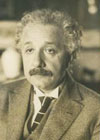Albert Einstein at the IISH
 Seventy-five years of systematic collection by the IISH does not only mean bringing together all kinds of collections from individuals and institutions who are important to social history, but also leads to a 'condensing' of documents from people whose own archives have not ended up at the Institute. Albert Einstein's (1879-1955) letters offer a good example of this process.
Seventy-five years of systematic collection by the IISH does not only mean bringing together all kinds of collections from individuals and institutions who are important to social history, but also leads to a 'condensing' of documents from people whose own archives have not ended up at the Institute. Albert Einstein's (1879-1955) letters offer a good example of this process.
On the occasion of the new president of the Royal Netherlands Academy of Arts and Sciences (KNAW) Robbert Dijkgraaf's introductory visit to the IISH (7 July 2008), we explored the possibility of exhibiting several of Einstein's letters. After all, Dijkgraaf is a renowned physicist and Einstein was once a foreign member of the KNAW. To our own surprise, a rummage through various archives did not only yield dozens of letters and manifests, but also a lecture with discussion, an unpublished preface, and various visual artefacts.
How did all of this 'Einsteiniana' end up here without the IISH never having deliberately set out to collect it? The reason is simple. Even before the start of his stormy scientific career, Einstein did not hide his views on social issues. He never aligned himself with a political party, since he was scared of losing his independence. However, the positions he took certainly put him on the left-hand side of the political spectrum. From the start of the First World War he declared himself to be a pacifist in principle - to the great displeasure of his fellow Academy members - and in Mein Weltbild (1934) he frankly asserted: "I consider social class distinctions to be unjustified and of late based on violence".
The IISH's collection of Einsteiniana spans the period of circa 1919 to 1947. A letter from an admirer, Minna Cauer, dated 19 November 1920, includes the following nice and laconic self-observation: "I am aware that as a person and a spirit I fall considerably short of the image that you project of me. But what difference does it make? Some people are destined to embody the illusions of others, and strangely enough I have become one of them. As long as one acknowledges this situation, no harm is done." That he was actually capable of this is clear from his capacity to admire others. For example, on 19th February 1925, he wrote the following to the famous social democrat Eduard Bernstein: "so few have consistently been faithful to the common good, even when it was bitter and thankless. Still fewer have taken it for granted and done so with such modesty as you", followed on 7 November 1926 by: "It would take a powerful Diogenes lantern to find a second person who is as good".
The most substantial part of the Einsteiniana found at the IISH is probably the account of a lecture with discussion about the concept of 'causality', which the famous scholar gave to the Marxistische Arbeiter Schule (M.A.S./MASCH) in Berlin on 14 November 1930. In his disgust for the strongly emerging national socialism, he sympathised with the communists who had established this school in the early 1930s. It is true that one of those present, Karl Korsch, had already left the KPD in 1923, but these kind of lectures could be attended by a far broader public. In 15 typed pages, he gives an account of the lecture, which was continually interrupted by questions that Einstein apparently answered co-operatively.
In the lion's den, he explained in response to one of the questions: "Marxists [...] attribute excessive significance to external causes. For example, Marxists like to say that the invention of machines is a consequence of external circumstances, such as a country's sparse population, labour shortages, etc. But the opposite is equally true." Later in the lecture, "a leading member of the M.A.S." returns to that theme by stating "that legitimacy in the rise of human civilization tends to reflect a statistical pattern, and that accordingly the more recent developments in physics are no cause for questioning causality as the foundation of communist policy."
Although Einstein says that he agrees with this, he cannot help adding the following: "These subtleties [i.e. the current KPD policy] are in no way indicative of the legal necessity of human history. This is entirely independent of whether the latest laws of nature are statistical or strictly causal." Korsch fails to note whether all of those present were satisfied with this response.
In the framework of the history of social movements, Einstein is, of course, mainly known for his efforts on behalf of the peace movement. It is curious that the protocol to establish a radical pacifistic International Peace House, which he signed together with the Dutch clergyman J.B. Th. Hugenholtz (1888-1973), never got off the ground due to Einstein's flight from the Nazis to Belgium and later to America.
See also:
Einstein Archives Online
Three Einstein manuscripts at Instituut-Lorentz, Leiden
The Einstein-Velikovsky Correspondence, at The Immanuel Velikovsky Archive
Verein für Geschichte der Arbeiterbewegung, Vienna
